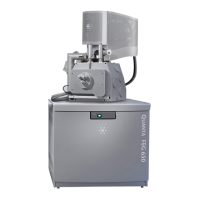
Do you have a question about the FEI Quanta FEG 250 and is the answer not in the manual?
| Electron Source | Field Emission Gun (FEG) |
|---|---|
| Stage | 5-axis motorized stage |
| Vacuum Modes | High Vacuum, Low Vacuum, ESEM |
| Stage Movement X | 100 mm |
| Stage Movement Y | 100 mm |
| Stage Movement Z | 50 mm |
| Stage Movement R | 360° continuous |
| Accelerating Voltage | 200 V to 30 kV |
| Resolution (Low Vacuum) | 3.0 nm |
| Magnification | Up to 1, 000, 000x |
| Detectors | Backscattered Electron Detector |
| Sample Size | Up to 100 mm |
| Vacuum System | Turbo-molecular pump, rotary vane pump |
| Operating Conditions Temperature | 15°C to 30°C |
| Operating Conditions Humidity | Up to 80% non-condensing |
| Type | Field Emission Gun Scanning Electron Microscope (FEG-SEM) |
Explanation of the four main components of the SEM system.
Details on the three main vacuum sections and operating modes.
Description of the three vacuum sections: Gun, Column, and Specimen Chamber.
Controls and indicators for vacuum states and pump/vent operations.
Explanation of High Vacuum (HiVac), Low Vacuum (LoVac), and ESEM modes.
Overview of system states: Shutdown, Standby, Overnight, and Full Operation.
Procedures for safely powering off the instrument and emergency shutdown.
Functionality of the server application for controlling microscope functions.
Overview of the main window elements and user interface.
Functions for stage navigation, alignment, and user units.
Accessing and configuring system settings via the Preferences dialogue.
Guidelines for preparing and handling specimens for SEM observation.
Pre-check procedures and conditions for obtaining an initial SEM image.
Techniques for improving image quality through adjustments.
Overview of available detectors and their configuration.
Overview of available alignment procedures and common rules.
Description of stage types and available sample holders.
Procedure for adjusting the stage to the eucentric position for optimal use.
Guide to common problems and their corrective actions.
Procedure for generating a system report for troubleshooting.
Information on various optional detectors like GBSD, STEM I, and vCD.
Technique for identifying elemental composition using X-rays.
Controlling sample temperature with cooling stages.
Controlling sample temperature up to 1500 °C with heating stages.
Method for improving microscope resolution at low accelerating voltages.